Tian Jin
MASLab: A Unified and Comprehensive Codebase for LLM-based Multi-Agent Systems
May 22, 2025Abstract:LLM-based multi-agent systems (MAS) have demonstrated significant potential in enhancing single LLMs to address complex and diverse tasks in practical applications. Despite considerable advancements, the field lacks a unified codebase that consolidates existing methods, resulting in redundant re-implementation efforts, unfair comparisons, and high entry barriers for researchers. To address these challenges, we introduce MASLab, a unified, comprehensive, and research-friendly codebase for LLM-based MAS. (1) MASLab integrates over 20 established methods across multiple domains, each rigorously validated by comparing step-by-step outputs with its official implementation. (2) MASLab provides a unified environment with various benchmarks for fair comparisons among methods, ensuring consistent inputs and standardized evaluation protocols. (3) MASLab implements methods within a shared streamlined structure, lowering the barriers for understanding and extension. Building on MASLab, we conduct extensive experiments covering 10+ benchmarks and 8 models, offering researchers a clear and comprehensive view of the current landscape of MAS methods. MASLab will continue to evolve, tracking the latest developments in the field, and invite contributions from the broader open-source community.
GraphMaster: Automated Graph Synthesis via LLM Agents in Data-Limited Environments
Apr 01, 2025Abstract:The era of foundation models has revolutionized AI research, yet Graph Foundation Models (GFMs) remain constrained by the scarcity of large-scale graph corpora. Traditional graph data synthesis techniques primarily focus on simplistic structural operations, lacking the capacity to generate semantically rich nodes with meaningful textual attributes: a critical limitation for real-world applications. While large language models (LLMs) demonstrate exceptional text generation capabilities, their direct application to graph synthesis is impeded by context window limitations, hallucination phenomena, and structural consistency challenges. To address these issues, we introduce GraphMaster, the first multi-agent framework specifically designed for graph data synthesis in data-limited environments. GraphMaster orchestrates four specialized LLM agents (Manager, Perception, Enhancement, and Evaluation) that collaboratively optimize the synthesis process through iterative refinement, ensuring both semantic coherence and structural integrity. To rigorously evaluate our approach, we create new data-limited "Sub" variants of six standard graph benchmarks, specifically designed to test synthesis capabilities under realistic constraints. Additionally, we develop a novel interpretability assessment framework that combines human evaluation with a principled Grassmannian manifold-based analysis, providing both qualitative and quantitative measures of semantic coherence. Experimental results demonstrate that GraphMaster significantly outperforms traditional synthesis methods across multiple datasets, establishing a strong foundation for advancing GFMs in data-scarce environments.
Unifying Structure and Activation: A Comprehensive Approach of Parameter and Memory Efficient Transfer Learning
Mar 11, 2025Abstract:Parameter-efficient transfer learning (PETL) aims to reduce the scales of pre-trained models for multiple downstream tasks. However, as the models keep scaling up, the memory footprint of existing PETL methods is not significantly reduced compared to the reduction of learnable parameters. This limitation hinders the practical deployment of PETL methods on memory-constrained devices. To this end, we proposed a new PETL framework, called Structure to Activation (S2A), to reduce the memory footprint of activation during fine-tuning. Specifically, our framework consists of: 1)Activation modules design(i.e. bias, prompt and side modules) in the parametric model structure, which results in a significant reduction of adjustable parameters and activation memory 2) 4-bit quantisation of activations based on their derivatives for non-parametric structures (e.g., nonlinear functions), which maintains accuracy while significantly reducing memory usage. Our S2A method consequently offers a lightweight solution in terms of both parameter and memory footprint. We evaluate S2A with different backbones and conduct extensive experiments on various datasets to evaluate the effectiveness. The results show that our method not only outperforms existing PETL techniques, achieving a fourfold reduction in GPU memory footprint on average, but also shows competitive performance in accuracy with lower tunable parameters. These also demonstrate that our method is highly suitable for practical transfer learning on hardware-constrained devices.
EDENet: Echo Direction Encoding Network for Place Recognition Based on Ground Penetrating Radar
Feb 28, 2025



Abstract:Ground penetrating radar (GPR) based localization has gained significant recognition in robotics due to its ability to detect stable subsurface features, offering advantages in environments where traditional sensors like cameras and LiDAR may struggle. However, existing methods are primarily focused on small-scale place recognition (PR), leaving the challenges of PR in large-scale maps unaddressed. These challenges include the inherent sparsity of underground features and the variability in underground dielectric constants, which complicate robust localization. In this work, we investigate the geometric relationship between GPR echo sequences and underground scenes, leveraging the robustness of directional features to inform our network design. We introduce learnable Gabor filters for the precise extraction of directional responses, coupled with a direction-aware attention mechanism for effective geometric encoding. To further enhance performance, we incorporate a shift-invariant unit and a multi-scale aggregation strategy to better accommodate variations in di-electric constants. Experiments conducted on public datasets demonstrate that our proposed EDENet not only surpasses existing solutions in terms of PR performance but also offers advantages in model size and computational efficiency.
Learning to Keep a Promise: Scaling Language Model Decoding Parallelism with Learned Asynchronous Decoding
Feb 17, 2025Abstract:Decoding with autoregressive large language models (LLMs) traditionally occurs sequentially, generating one token after another. An emerging line of work explored parallel decoding by identifying and simultaneously generating semantically independent chunks of LLM responses. However, these techniques rely on hand-crafted heuristics tied to syntactic structures like lists and paragraphs, making them rigid and imprecise. We present PASTA, a learning-based system that teaches LLMs to identify semantic independence and express parallel decoding opportunities in their own responses. At its core are PASTA-LANG and its interpreter: PASTA-LANG is an annotation language that enables LLMs to express semantic independence in their own responses; the language interpreter acts on these annotations to orchestrate parallel decoding on-the-fly at inference time. Through a two-stage finetuning process, we train LLMs to generate PASTA-LANG annotations that optimize both response quality and decoding speed. Evaluation on AlpacaEval, an instruction following benchmark, shows that our approach Pareto-dominates existing methods in terms of decoding speed and response quality; our results demonstrate geometric mean speedups ranging from 1.21x to 1.93x with corresponding quality changes of +2.2% to -7.1%, measured by length-controlled win rates against sequential decoding baseline.
FedMobileAgent: Training Mobile Agents Using Decentralized Self-Sourced Data from Diverse Users
Feb 05, 2025



Abstract:The advancement of mobile agents has opened new opportunities for automating tasks on mobile devices. Training these agents requires large-scale high-quality data, which is costly using human labor. Given the vast number of mobile phone users worldwide, if automated data collection from them is feasible, the resulting data volume and the subsequently trained mobile agents could reach unprecedented levels. Nevertheless, two major challenges arise: (1) extracting high-level and low-level user instructions without involving human and (2) utilizing distributed data from diverse users while preserving privacy. To tackle these challenges, we propose FedMobileAgent, a collaborative framework that trains mobile agents using self-sourced data from diverse users. Specifically, it includes two techniques. First, we propose Auto-Annotation, which enables the automatic collection of high-quality datasets during users' routine phone usage with minimal cost. Second, we introduce adapted aggregation to improve federated training of mobile agents on non-IID user data, by incorporating both episode- and step-level distributions. In distributed settings, FedMobileAgent achieves performance comparable to centralized human-annotated models at less than 0.02\% of the cost, highlighting its potential for real-world applications.
The Moral Case for Using Language Model Agents for Recommendation
Oct 15, 2024Abstract:Our information and communication environment has fallen short of the ideals that networked global communication might have served. Identifying all the causes of its pathologies is difficult, but existing recommender systems very likely play a contributing role. In this paper, which draws on the normative tools of philosophy of computing, informed by empirical and technical insights from natural language processing and recommender systems, we make the moral case for an alternative approach. We argue that existing recommenders incentivise mass surveillance, concentrate power, fall prey to narrow behaviourism, and compromise user agency. Rather than just trying to avoid algorithms entirely, or to make incremental improvements to the current paradigm, researchers and engineers should explore an alternative paradigm: the use of language model (LM) agents to source and curate content that matches users' preferences and values, expressed in natural language. The use of LM agents for recommendation poses its own challenges, including those related to candidate generation, computational efficiency, preference modelling, and prompt injection. Nonetheless, if implemented successfully LM agents could: guide us through the digital public sphere without relying on mass surveillance; shift power away from platforms towards users; optimise for what matters instead of just for behavioural proxies; and scaffold our agency instead of undermining it.
Using Geometrical information to Measure the Vibration of A Swaying Millimeter-wave Radar
Jun 19, 2024Abstract:This paper presents two new, simple yet effective approaches to measure the vibration of a swaying millimeter-wave radar (mmRadar) utilizing geometrical information. Specifically, for the planar vibrations, we firstly establish an equation based on the area difference between the swaying mmRadar and the reference objects at different moments, which enables the quantification of planar displacement. Secondly, volume differences are also utilized with the same idea, achieving the self-vibration measurement of a swaying mmRadar for spatial vibrations. Experimental results confirm the effectiveness of our methods, demonstrating its capability to estimate both the amplitude and a crude direction of the mmRadar's self-vibration.
BERT: Accelerating Vital Signs Measurement for Bioradar with An Efficient Recursive Technique
Apr 20, 2024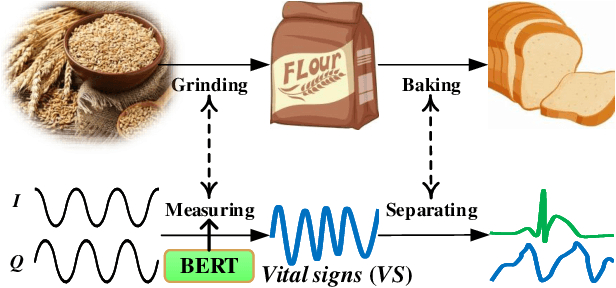

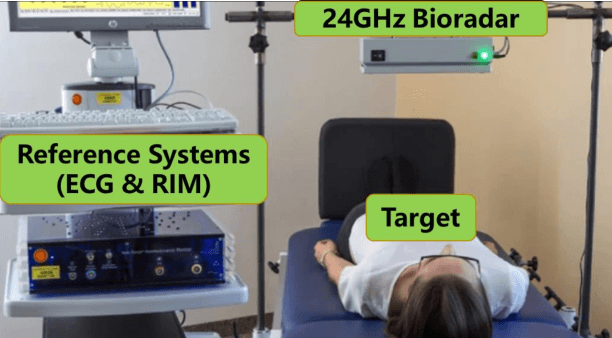
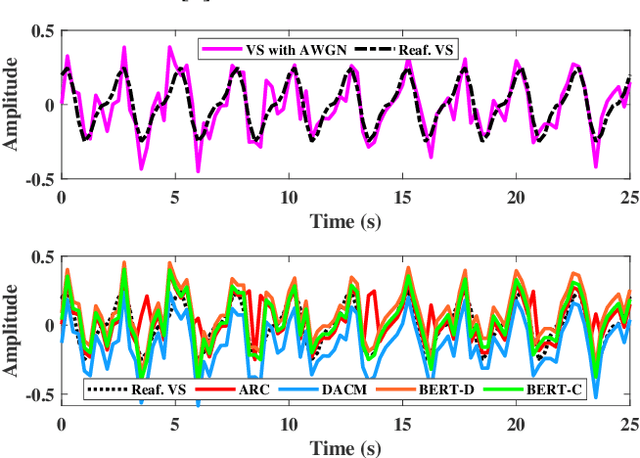
Abstract:Recent years have witnessed the great advance of bioradar system in smart sensing of vital signs (VS) for human healthcare monitoring. As an important part of VS sensing process, VS measurement aims to capture the chest wall micromotion induced by the human respiratory and cardiac activities. Unfortunately, the existing VS measurement methods using bioradar have encountered bottlenecks in making a trade-off between time cost and measurement accuracy. To break this bottleneck, this letter proposes an efficient recursive technique (BERT) heuristically, based on the observation that the features of bioradar VS meet the conditions of Markov model. Extensive experimental results validate that BERT measurement yields lower time costs, competitive estimates of heart rate, breathing rate, and heart rate variability. Our BERT method is promising us a new and superior option to measure VS for bioradar. This work seeks not only to solve the current issue of how to accelerate VS measurement with an acceptable accuracy, but also to inspire creative new ideas that spur further advances in this promising field in the future.
Self-Selected Attention Span for Accelerating Large Language Model Inference
Apr 14, 2024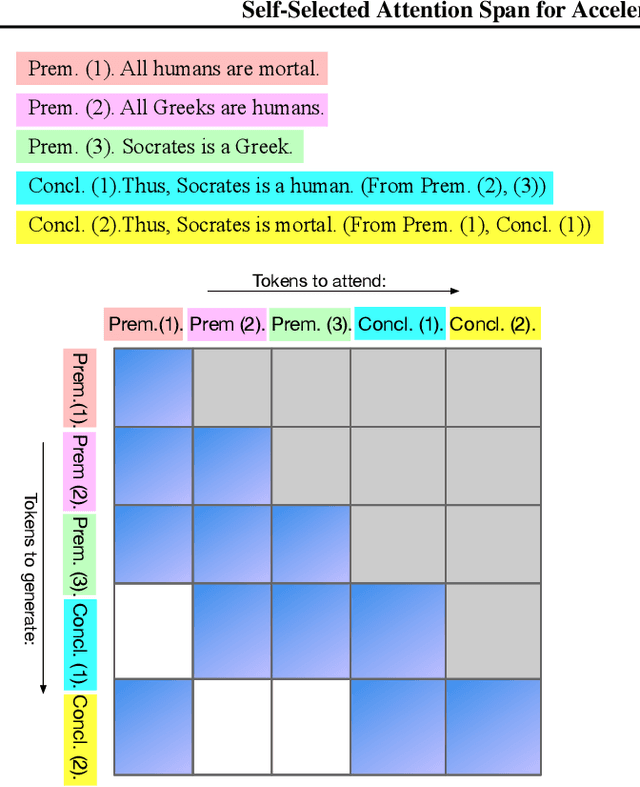
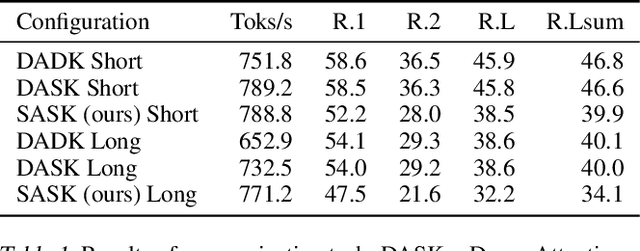
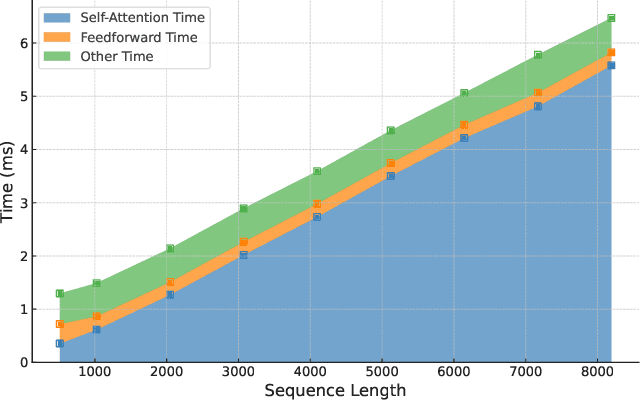

Abstract:Large language models (LLMs) can solve challenging tasks. However, their inference computation on modern GPUs is highly inefficient due to the increasing number of tokens they must attend to as they generate new ones. To address this inefficiency, we capitalize on LLMs' problem-solving capabilities to optimize their own inference-time efficiency. We demonstrate with two specific tasks: (a) evaluating complex arithmetic expressions and (b) summarizing news articles. For both tasks, we create custom datasets to fine-tune an LLM. The goal of fine-tuning is twofold: first, to make the LLM learn to solve the evaluation or summarization task, and second, to train it to identify the minimal attention spans required for each step of the task. As a result, the fine-tuned model is able to convert these self-identified minimal attention spans into sparse attention masks on-the-fly during inference. We develop a custom CUDA kernel to take advantage of the reduced context to attend to. We demonstrate that using this custom CUDA kernel improves the throughput of LLM inference by 28%. Our work presents an end-to-end demonstration showing that training LLMs to self-select their attention spans speeds up autoregressive inference in solving real-world tasks.
 Add to Chrome
Add to Chrome Add to Firefox
Add to Firefox Add to Edge
Add to Edge